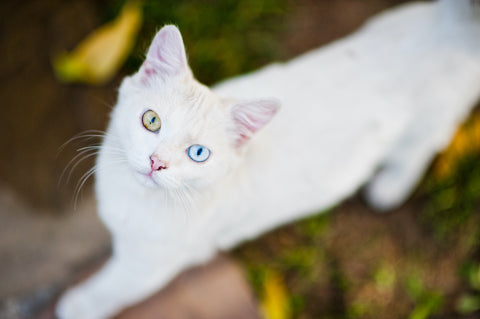A Journey into the Cat's Eye: How many colors can cats see?
Cats, with their enigmatic gaze and stealthy ways, possess a vision that's as unique as their personality. While we humans perceive a vivid tapestry of colors, a cat's world is painted with a different brush.
Let's embark on a fascinating journey into the realm of a cat's vision, exploring the limited yet intriguing spectrum of colors they perceive.
Delving into the Colorful Realm of Cat Vision
The Palette of a Cat's Vision
Cats, these graceful creatures with mesmerizing eyes, perceive the world through a palette woven with subtlety and nuance. Unlike the rich spectrum humans experience, a cat's vision paints a canvas of selective hues.
Dichromatic Vision
At the heart of a cat's perception lies a dichromatic view. While humans possess three types of color receptors, or cones, cats have just two. This distinction shapes their color perception, granting them a world defined by shades of blue and green.
Shades of the World
Reds and oranges appear more like muted tones to cats, blending into a spectrum of grays. However, blues and greens stand out vividly in their sight. Understanding this limited color range helps us appreciate how a cat's visual perception shapes its interaction with the environment.
How Cats See the World?
Thriving in Twilight
As nocturnal hunters, cats are adept at navigating the dimly lit world. Their vision surpasses human capabilities in low light conditions. A higher concentration of rod cells coupled with the tapetum lucidum—a reflective layer behind the retina—imbues their eyes with a mystical radiance in darkness.
Precision in Hunt
A cat's vision isn’t solely about color; it's a masterpiece of motion detection. Their eyes, finely attuned to detect even the faintest movements, contribute to their prowess as skilled hunters. With a wide field of view and acute peripheral vision, they stalk their prey with unrivaled precision.
Pupil Adaptability
Cats' pupils can dilate and contract rapidly, adjusting to changes in light levels. This ability allows them to regulate the amount of light that enters their eyes, aiding their vision in both bright daylight and low-light conditions.
Depth Perception
While cats might not have the same depth perception as humans due to their binocular vision (the ability to use both eyes together to perceive depth), they compensate with other senses, such as their acute hearing and precise sense of touch using their whiskers. This combination helps them navigate and judge distances accurately.
Visual Acuity
Cats have better visual acuity than humans in dim light but lower acuity in bright light. They compensate for this by having a higher number of rod cells in their retinas, allowing them to detect motion and see better in low light conditions.
Blurry Close Vision
Cats' eyes are designed more for distance vision than close-up focus. They might not see objects up close as clearly as humans do, but their other senses compensate for this limitation.
Peripheral Vision
Cats have a wide field of view. While their central vision might not be as sharp as humans', their peripheral vision is excellent. This allows them to spot potential threats or prey from various angles without needing to move their heads much.
Emotions in the Gaze
Cats use their eyes for communication. Beyond sight, a cat's eyes serve as windows to their emotions. They have subtle ways of expressing emotions through their eyes, such as dilating pupils when excited or narrowing them when feeling threatened. Their blinking patterns convey trust, establishing a silent yet profound communication channel. Blinking slowly can be a sign of trust or contentment in cat communication.
Intriguingly, a cat’s eyes also serve as windows to their emotions. From dilated pupils reflecting excitement to narrowed eyes signaling caution, cats communicate a myriad of feelings through their gaze. Their blinking patterns convey trust and contentment, adding depth to their silent language.

Seeing Through Cat Eyes
Understanding the cat's visual realm unveils the artistry within their everyday experiences. It's a reminder that richness doesn’t always lie in a multitude of hues but in the intricate dance of shades that define their unique perspective.
While cats might not marvel at a rainbow's array of colors, their vision is a testament to adaptation and precision in the animal kingdom. Exploring their world through the lens of limited color perception sheds light on their extraordinary ability to thrive in diverse environments.
The next time you catch your feline companion gazing into the horizon, remember, their world might not be as colorful as ours, but it’s undoubtedly vibrant in its own unique way.
Leave a comment
